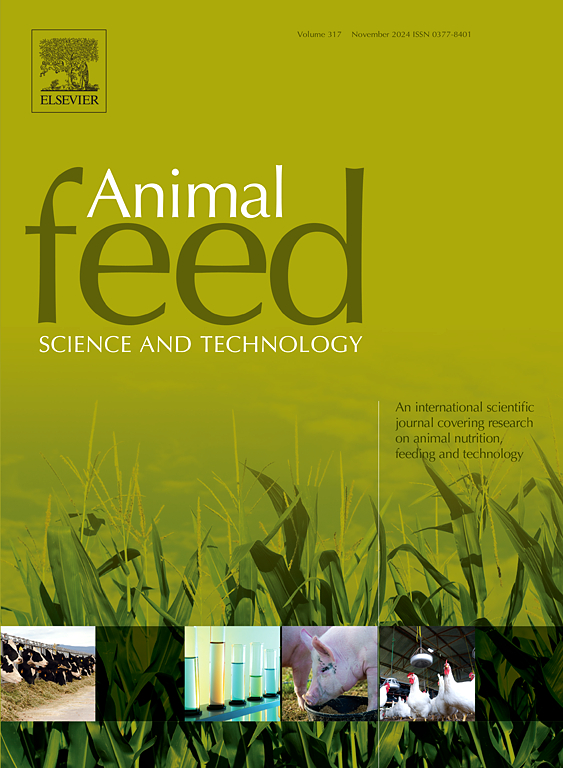Effects of selenium-enriched Bacillus pumilus on the growth performance, blood biochemical parameters, innate immune response, and oxidative activity Nile tilapia (Oreochromis niloticus) fed fishmeal-free diets
IF 2.5
2区 农林科学
Q1 AGRICULTURE, DAIRY & ANIMAL SCIENCE
引用次数: 0
Abstract
The present study is the first step towards optimizing Nile tilapia (Oreochromis niloticus) performance through a fishmeal-free diet with selenium forms (Se) and Se-enriched Bacillus pumilus. Consequently, the present interest is to study their effect on immune response and growth performance that are directly affected by hemato-biochemical indices along with analyses of intestinal histomorphology and other hepatic antioxidant enzymes in Nile tilapia. The study utilized a 2 × 3 factorial feeding design involving 450 tilapia fingerlings, each with an average body weight of 3.23 ± 0.09 g. The fish were distributed into 18 cylindrical plastic tanks, each with a volume of 0.5 m³ , containing 25 fish per tank. Six experimental diets were formulated, all of which were isonitrogenous (30 % crude protein) and isoenergetic. The diets included: A supplement-free control diet (T1), a diet supplemented with B. pumilus (T2, at concentration of 1.85 ×105 CFU kg−1), a diet containing 0.4 mg/kg selenomethionine (T3, O Se), a diet that was O Se-enriched with B. pumilus (T4), a diet with 0.4 mg/kg sodium selenite (T5, I Se), and a diet that was I Se-enriched with B. pumilus (T6). The outcome of the feeding experiment indicates that the inclusion of Se or B. pumilus significantly improved weight gain, final body weight, protein efficiency ratio (PER), average daily gain (ADG), specific growth rate (SGR), and feed intake in fish compared to supplement-free diet, with the highest growth indices and the best FCR recorded in organic selenium-enriched diets. The intestinal histomorphometry including intestinal villous width, absorption surface area, and goblet cells was enhanced when tilapia receiving diet fortified with selenium. The best results were observed in the organic selenium-supplemented diet. Also, diet fortified with selenium exhibited significantly raised hematocrit, leucocyte, monocytes, and lymphocytes compared to supplement-free diet. The B. pumilus enriched selenium forms and B. pumilus significantly affected these indices, with the highest Hb in group fed B. pumilus. Moreover, a notable decline was detected in aspartate aminotransferase (AST) and alanine aminotransferase (ALT) levels as opposed to a diet without supplementation in response to the addition of Se forms or B. pumilus (P < 0.05). Also, B. pumilus enriched-O Se significantly enhanced serum globulin, total protein, and albumin levels. While selenium supplementation considerable decreased lipid profiles in fish, particularly those fed a diet supplemented with organic selenium. Inorganic selenium supplementation led to the lowest glucose levels, while the highest was in supplement-free diet. Fish fed selenium forms or B. pumilus showed increased hepatic antioxidant activities, particularly in a diet enriched with organic selenium, while malondialdehyde (MDA) and nitric oxide (NO) concentrations decreased. There was an increase in IgM and C4 levels in fish that consumed a B. pumilus diet. From this, it can be derived that O Se-enriched B. pumilusis the best choice for dietary supplementation for enhancing growth, immune response, intestinal histomorphology, hepatic antioxidant enzymes, and hemato-biochemical indices in Nile tilapia.
富硒矮芽孢杆菌对无鱼粉饲料中尼罗罗非鱼生长性能、血液生化指标、先天免疫反应和氧化活性的影响
本研究是在尼罗罗非鱼(Oreochromis niloticus)无鱼粉饲料中添加硒形式(Se)和富硒短芽孢杆菌(Bacillus pumilus)来优化生产性能的第一步。因此,目前的兴趣是研究它们对尼罗罗非鱼免疫反应和生长性能的影响,这些影响直接受血液生化指标的影响,以及肠道组织形态学和其他肝脏抗氧化酶的分析。采用2 × 3因子饲养设计,450尾罗非鱼鱼种平均体重为3.23 ± 0.09 g。鱼被分配到18个圆柱形塑料水箱中,每个水箱的体积为0.5 m³ ,每个水箱可容纳25条鱼。配制6种等氮(粗蛋白质30% %)等能试验饲粮。试验饲粮包括:不添加补体的对照饲粮(T1)、添加矮螺旋藻的饲粮(T2,浓度为1.85 ×105 CFU kg−1)、添加0.4 mg/kg硒代蛋氨酸(T3, O Se)的饲粮、添加0.4 mg/kg亚硒酸钠(T5, I Se)的饲粮和添加I硒的矮螺旋藻(T6)的饲粮。饲养试验结果表明,与不添加硒的饲料相比,添加硒或细粒双头藻显著提高了鱼的增重、最终体重、蛋白质效率(PER)、平均日增重(ADG)、特定生长率(SGR)和采食量,其中富硒有机饲料的生长指标最高,饲料效率(FCR)最好。添加硒后,罗非鱼的肠组织形态学包括肠绒毛宽度、吸收表面积和杯状细胞均有所增强。以有机硒补充日粮效果最好。此外,与不添加硒的饮食相比,添加硒的饮食显著提高了血细胞比容、白细胞、单核细胞和淋巴细胞。富硒组和富硒组对上述指标均有显著影响,其中以富硒组Hb最高。此外,在饲粮中添加硒或短叶杆菌显著降低了天冬氨酸转氨酶(AST)和丙氨酸转氨酶(ALT)水平(P <; 0.05)。此外,矮分枝杆菌富集- o硒显著提高血清球蛋白、总蛋白和白蛋白水平。而硒的补充显著降低了鱼类的脂质分布,特别是那些饲料中添加了有机硒的鱼类。补充无机硒导致葡萄糖水平最低,而不添加硒的饮食中葡萄糖水平最高。饲料中添加硒或细粒双歧杆菌的鱼显示出肝脏抗氧化活性增加,特别是在富含有机硒的饲料中,而丙二醛(MDA)和一氧化氮(NO)浓度降低。食用细螺旋体饲料的鱼体内IgM和C4水平升高。由此可见,在尼罗罗非鱼饲料中添加富O硒双歧杆菌是提高其生长、免疫应答、肠道组织形态、肝脏抗氧化酶和血液生化指标的最佳选择。
本文章由计算机程序翻译,如有差异,请以英文原文为准。
求助全文
约1分钟内获得全文
求助全文
来源期刊

Animal Feed Science and Technology
农林科学-奶制品与动物科学
CiteScore
6.00
自引率
6.20%
发文量
266
审稿时长
3 months
期刊介绍:
Animal Feed Science and Technology is a unique journal publishing scientific papers of international interest focusing on animal feeds and their feeding.
Papers describing research on feed for ruminants and non-ruminants, including poultry, horses, companion animals and aquatic animals, are welcome.
The journal covers the following areas:
Nutritive value of feeds (e.g., assessment, improvement)
Methods of conserving and processing feeds that affect their nutritional value
Agronomic and climatic factors influencing the nutritive value of feeds
Utilization of feeds and the improvement of such
Metabolic, production, reproduction and health responses, as well as potential environmental impacts, of diet inputs and feed technologies (e.g., feeds, feed additives, feed components, mycotoxins)
Mathematical models relating directly to animal-feed interactions
Analytical and experimental methods for feed evaluation
Environmental impacts of feed technologies in animal production.
 求助内容:
求助内容: 应助结果提醒方式:
应助结果提醒方式:


